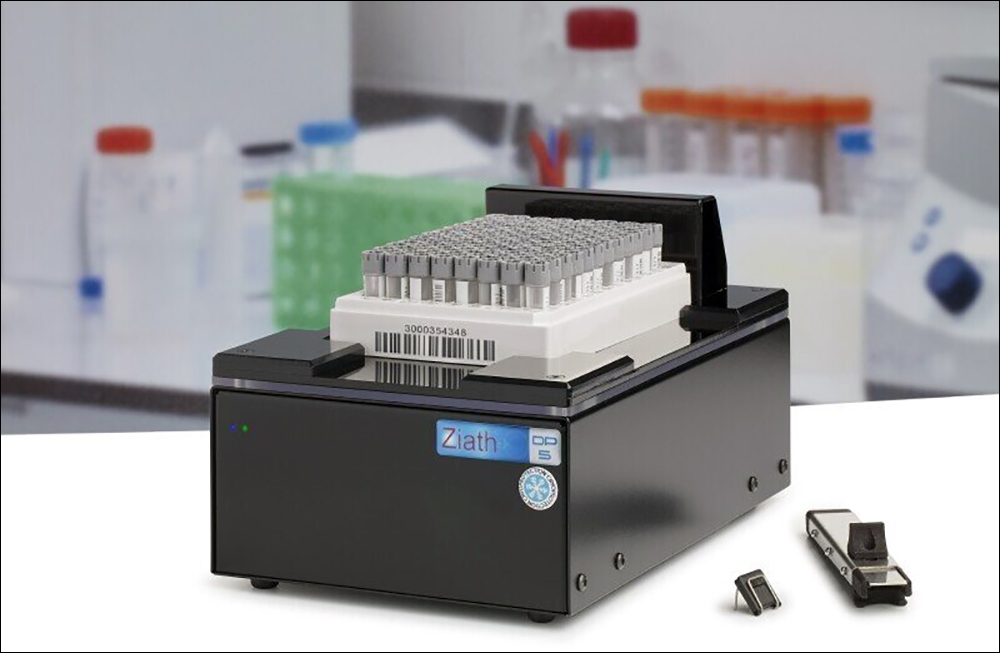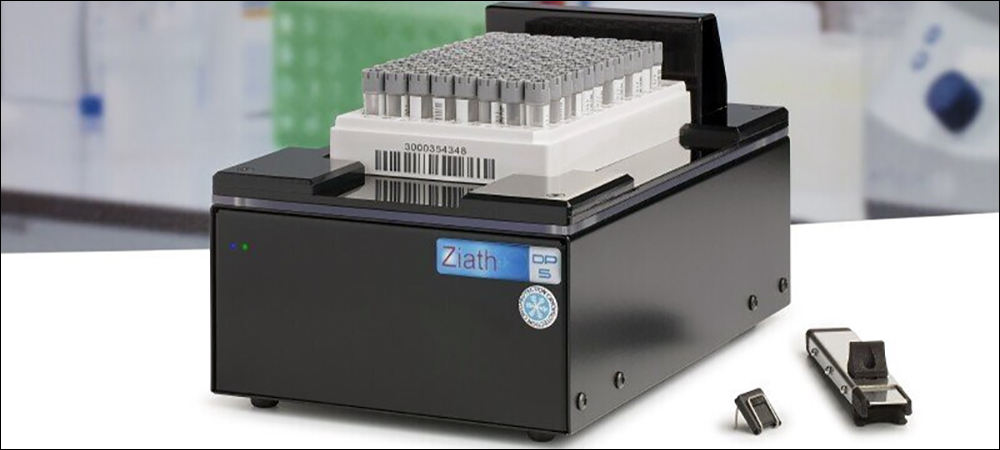U.K.-based biomedical technology company Ziath is offering a radio frequency identification (RFID) solution to address the uniquely challenging environment of cryogenics management. The solution, known as Ri-Track, consists of a high-frequency (HF) RFID Ri-Track Mirage tag-reading and barcode-scanning device, as well as 13.56 MHZ RFID tags compliant with the ISO 15693 standard, attached to trays full of barcoded tubes.
Ziath offers an app with which users can interrogate the tags via their Android-based smartphones in order to access data based on the tag reads. The company, a subsidiary of Azenta Life Sciences, develops products for sample management, tracking and inventory control. Its solutions leverage 2D-barcoded tubes that are used by life-science organizations, academia, and biotechnology and pharmaceutical firms.

Ziath’s Ri-Track device
Companies and laboratories are storing biological samples in small, capped tubes, which in turn are held in carriers called racks, immersed in vapor-phase liquid nitrogen to be chilled. The tubes within the racks can store DNA or tissue samples, as well as other medical samples or embryos. When Ziath’s technology scans each tube’s barcode, users thus gain an automated digital identification of that sample, enabling them to manage samples as they are stored, moved or processed.
However, the environment poses challenges for barcode scanning, since biological samples are often stored at extremely cold temperatures. For example, liquid nitrogen temperatures can be as low as -196 degrees Celsius (-320 degrees Fahrenheit). In some cases, samples are accessed by lab workers, and they may begin to warm up before being lowered back into liquid nitrogen. As a result, the barcodes may be covered in condensed water-based ice and frost, and thus might not be readable.
“That’s where the RFID really comes into its own,” explains Steve Knight, Ziath’s director of European marketing, “because it doesn’t care whether the tube is covered in ice. It’s still got all of the information.” RFID tag reads are quicker and easier than using alcohol to clear the laser-etched barcodes that have been frosted over, he adds.
How the System Works
Since RFID tags are not readily available for the tubes’ size and form factor, Ziath says it takes a different approach. It has patented an RFID tag that is applied to each rack, in which up to 96 samples can be stored. The solution employs hybrid technology. The Ri-Track Mirage is a cryogenic reader and scanner on which standard SBS-format racks can be placed. The SBS format—named for the Society for Biomolecular Screening, now called the Society for Laboratory Automation and Screening (SLAS)—is the universally accepted form factor for trays in laboratory automation.

Steve Knight
Users can purchase the reading device along with a tool for inserting tags into the racks. Ri-Track tags fit securely into the internal space of tube racks, the company reports. On each tube’s circular base is a printed or etched 2D barcode with up to 128 characters. The tubes are loaded into the tray, with each barcode facing down, where it will be exposed to the barcode scanner through holes in the base of the rack. Once users have inserted a specialized HF RFID tag into one end of the rack, they can place the tray on the Mirage device to scan each tube’s barcode, then write that data onto the tag, including the tube’s location within the tray as a three-digit alphanumeric, A01 to H12.
That information is linked to the lab’s management software, and the tray can be moved into storage. Scientists typically remove trays from the freezer to process or move samples, after which they place each rack onto a Ri-Track Mirage reader, which takes an optical scan of all the barcodes. If a barcode is covered in frost or ice, that tag read will provide the necessary data as a form of redundancy. Thus, each time the track is removed from cold storage, every tube’s details can be read, even if any are ice-obscured.
In addition, the system can compare RFID tag data with what the barcode scanner detects, and thereby identify if someone has moved the tubes around. The tags can also be used with any Near Field Communication (NFC)-enabled phone running the Ri-Track app. In that way, users can wave their cell phone above the rack and view a diagram of all tubes. By using phones even at a cold-storage location, users can identify samples without having to take them into a room-temperature environment for scanning.
Overcoming the Challenges of RFID in Liquid Nitrogen
That is significant for large pharmaceutical companies, Ziath notes, because workers may be required to walk into a freezer set at -80 degrees Celsius (-112 degrees Fahrenheit), and they would not want to remain inside for long. In the past, users would often need to grab racks for scanning and hope they chose the right ones. With phone-based RFID reads, however, they can now identify the correct trays immediately.
The company performed some innovation to create a robust RFID tag that would function in challenging environments. Most tags that fail under such conditions, Knight explains, tend to do so at the weakest link, where the antenna and the chip are soldered together. Ziath’s engineers have developed an alternative, he says, by which the antenna is crimped to the chip so there is no solder joint that would be prone to failure. As the tag’s metal components expand at different rates, the antenna and chip can sustain such temperatures and still operate.
The next phase of the project may include further miniaturizing the tray’s RFID tag, Knight predicts, so that a tag could be applied to every tube. “That would obviously be more convenient for everybody,” he states. The company plans to release the Ri-Track solution commercially in September 2023. It demonstrated the system at a laboratory automation and screening show in San Diego this past February. “We just got a fantastic response from all the scientists who saw it.”
In addition, Ziath has built a Lego robotics rig to dip the RFID tags into and out of liquid nitrogen, then to thaw them and read them each time. So far, the company reports, the tags have worked during 8,500 cycles, and Ziath expects to be able to accomplish up to 10,000 cycles of moving the tags into and out of cold-storage temperatures.
Key Takeaways:
- Ziath is releasing a solution that leverages HF RFID to capture and store data regarding biological samples in cold storage.
- The company engineered a specialized tag designed to sustain temperatures as low as -196 Celsius, even when the tag is moved to a room-temperature environment and then back to cold storage.


